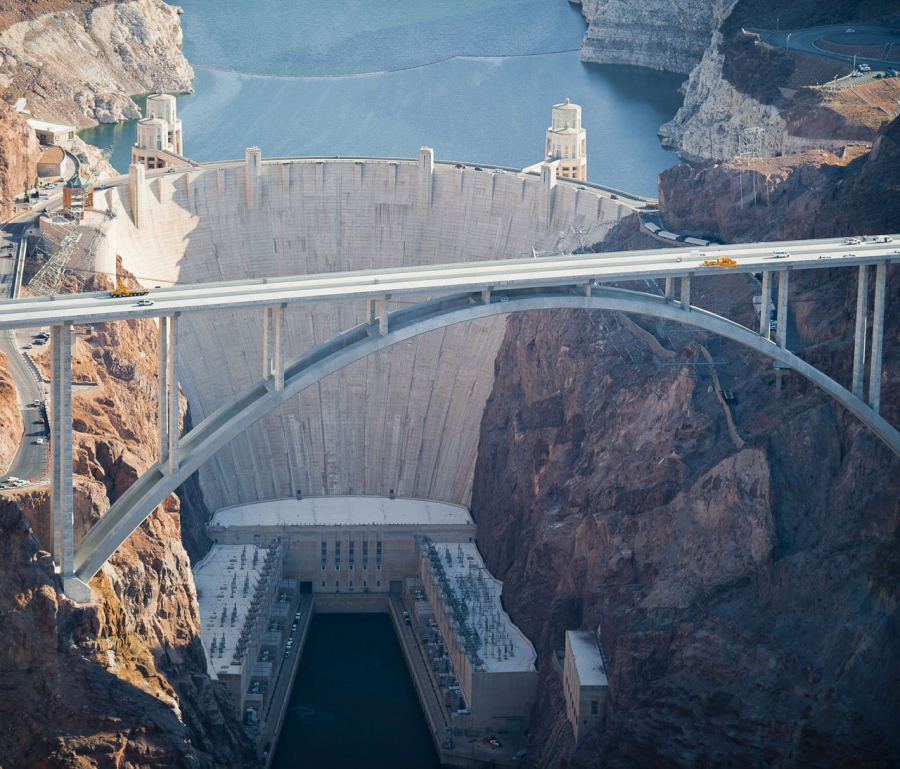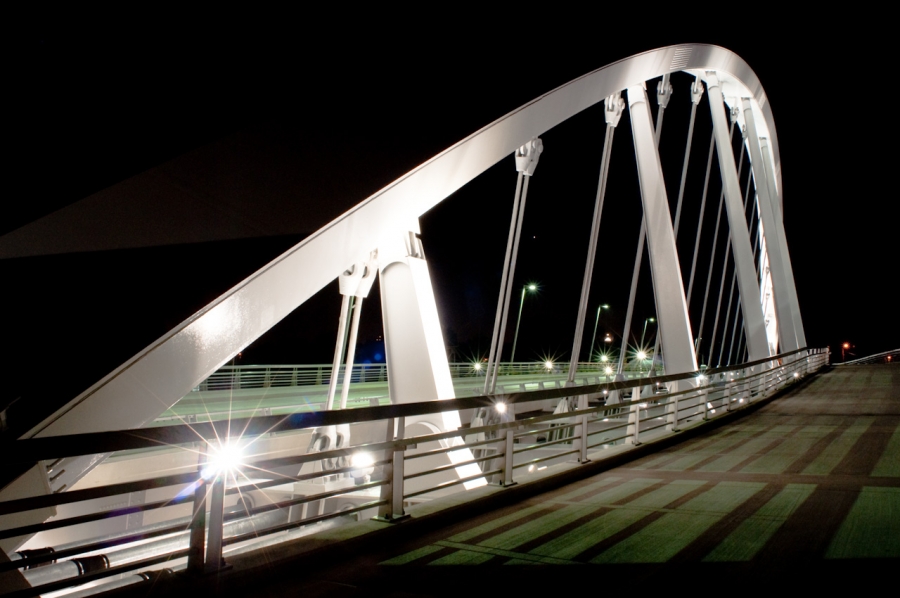The Hoover Dam Bypass: A Modern Engineering Marvel
The Hoover Dam Bypass is being described as a remarkable, magnificent, impressive, spectacular, and monumental engineering feat. Completed in October 2010, this $240 million civil engineering project took nearly a decade of intensive planning and preparation, required coordinated efforts among a six-agency management consortium, and consisted of a three-prong emphasis on design, safety, and economic considerations.
 Photo by Keith Philpott, courtesy of HDR
Photo by Keith Philpott, courtesy of HDR
Necessitated by the rerouting of traffic from the stretch of U.S. Route 93 that crosses above the Hoover Dam, the complex and multifaceted project spanned a 3.5-mile corridor, including one mile of roadway in Arizona, 2.1 miles of roadway in Nevada, and a 1,900' crossing of the Colorado River.
The greatest engineering marvel of the project is undoubtedly the new Mike O'Callaghan/Pat Tillman Memorial Bridge, which opened in October 2010. Designated as the highest and longest arched concrete bridge in the western hemisphere, it spans 1,900' and rests 890' above the Colorado River.
The First Steel/Concrete Arch Bridge in the United States
The Mike O'Callaghan/Pat Tillman Memorial Bridge is the first steel–concrete hybrid arch bridge in the United States. Its high-performance concrete arch was designed to complement the Hoover Dam without detracting from its views and appeal as a major tourism landmark, while its modern steel superstructure was engineered to manage load demands.
“To combat potential side-to-side motion from a massive earthquake or high winds, the two concrete arches are connected with steel struts to provide greater lateral strength, while a composite steel superstructure for the roadway deck addresses live load capacity,” says Bill Dowd with HDR, who served as project director for the entire Hoover Support Design Team (HDR, T.Y. Lin International, and Jacobs Engineering). “Trapezoidal steel box girders in the superstructure integrated with post-tensioned concrete caps allow the roadway deck to also serve as lateral bracing for the precast concrete columns, which are the tallest in the world.”
According to Dowd, although the spectacular setting provided a backdrop for engineering excellence, it also proved to be one of the team’s greatest challenges. Working in the steep, rugged terrain of the Black Canyon required rock cuts and fills that exceeded 100' in height. In addition, the team had to account for winds of up to 70 miles per hour and set concrete at night to avoid temperatures exceeding 120 degrees.
In addition to its success as a modern-day construction marvel, the Hoover Dam Bypass also serves as a best-practice model for the industry due to the size of the project and the complexity of the team structure and dynamics. The project was initiated and managed by the Central Federal Lands Highway Division (CFLHD) of the Federal Highway Administration, which awarded a contract in 2001 to top-ranked engineering firm HDR for design and construction support services. Under the management of the CFLHD, HDR led an integrated team of multiple firms and specialty sub-consultants to complete the job.
Partnership Between Engineers
“We had a true partnership among the Hoover Support Design Team members, which allowed for innovation at micro and macro levels,” says Zanetell. “Despite the highly complex circumstances of the project, all six of the civil projects that entailed the Hoover Dam Bypass were completed without a single dispute and within the original budget.”
In addition to designing and constructing the Mike O'Callaghan/Pat Tillman Memorial Bridge, the Hoover Support Design Team was also responsible for roadway grading and paving, construction of six other bridges, wildlife crossings, drainage, lighting, utilities, traffic management systems, pedestrian accommodations, interpretive exhibits, high-voltage transmission line relocations, geotechnical engineering, surveying and mapping, and bypass corridor architectural design.
The Mike O'Callaghan/Pat Tillman Memorial Bridge was designed by a joint team led by T.Y. Lin International, with major support from HDR. HDR designed the Nevada approach, including a high-level crossing of Gold Strike Canyon, while subcontractor Jacobs Engineering (formerly Sverdrup) designed the Arizona approach, which consists of a major bridge near Sugarloaf Mountain and the Arizona Interchange.
Protecting the Hoover Legacy
The Hoover Dam Bypass diverts traffic away from the two-lane stretch of U.S. Route 93 that crosses above the Hoover Dam. Characterized by traffic bottlenecks, narrow roadways, dangerous hairpin turns, switchbacks, and a 200' drop in elevation on the roadways approaching the dam, this stretch of U.S. Route 93 has an accident rate three times higher that of any other stretch of the route.
In addition to improving motorist and pedestrian safety, removing interstate through-traffic from the Hoover Dam reduces the vulnerability of the site as a potential terrorist target, protects the sustainable hydroelectric power the dam supplies to the southwest, helps to prevent hazardous chemical spills that would threaten the region’s water supply, and serves to reduce travel time and fuel consumption for truckers and local drivers.
The Hoover Dam Bypass also promotes economic vitality and regional mobility by restoring a critical NAFTA trade route. Immediately following 9/11, trucks were diverted 23 miles from the dam as a security precaution, costing $30 million annually in delays and fuel consumption. Approximately 2,000 trucks per day are expected to return to a safer and faster U.S. Route 93 now that the project is complete. “The Hoover Dam Bypass is a rare modern project that captured the spirit of American ingenuity, inspiring interest from the general public and the engineering industry,” says Dowd. “It truly bridges greatness between the iconic marvel it protects and the brilliant problem solving of modern engineering.”

Lisa Taylor Minor
Lisa Taylor is a freelance writer and marketing consultant. She has more than 16 years of experience as a communications professional and has worked with a variety of companies in the home products and building materials industry. Originally from Memphis, TN, Lisa earned a BA in Journalism from the University of Memphis in 1995 and a MA in Journalism from the University of Memphis in 1997. She spent the first 11 years of her career working in account service for Memphis advertising agencies Thompson & Company, Oden Marketing & Design, and Carpenter/Sullivan. Lisa then spent five years in Nashville, TN, with The Buntin Group, an Adweek Top 100 U.S. advertising agency, and Louisiana-Pacific Corporation, a leading manufacturer of building materials. Lisa currently lives in Denver, CO, and is Principal/Owner of Wazee Marketing.
Website: www.wazeemarketing.com




